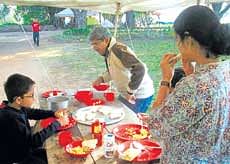Trails to walk, tents to pitch

You must go camping at least once in your lifetime. Why? Because camping introduces a man to himself.
In India, the best time to go camping is during winter. So pick up your haversack, drive out of the city, search for a good campsite and go pitch your tent. Winter will be gone in a few days.
There are some operators in India who run campsites, but they are few and far between. If you’re a first-timer, going to an established campsite is your best option. But if you’re the adventurous type, you can drive off on your own and pitch your tent wherever you feel like. Dedicated campsites usually have some amenities.
These include:
Fire pits in which to build campfires
Pit toilets
Road access for vehicles
Picnic tables
Piped potable water
Flush toilets and showers
Raised platforms on which to set up tents
Marked spaces indicating a boundary for one camper or a group of campers
Wood for free or for sale for use in cooking or for a campfire
Garbage cans or large rubbish bins in which to place refuse
What you need to carry
Tent
Hammer to drive tent stakes into the soil
Sleeping bag and/or blankets for warmth
Sleeping pad or air mattress, to be placed underneath the sleeping bag for cushioning from stones and twigs as well as for insulation from the ground
First aid kit
Lantern or flashlight
Folding chairs to place around the campfire
Ropes for stringing clothes line and for securing the shelter
Raincoat
Hiking boots
Rubber slippers
Trash bags, particularly some with handles so that they can be tied to a tree limb
Insect repellent
Change of clothes, basic personal care products and towel
Cooler/Icebox, in case you’re carrying perishables and beverages
Beverages or portable water filter for areas that have access to rivers or lakes
A tripod grill, that can be used for cooking on a campfire
Food
Drinking water
Marinated food items and skewers for the barbecue
How to choose a campsite
If you’ve decided to choose your own campsite as opposed to going to a dedicated one, easy availability of running water is a must. So look for a patch of flat land, which is not a private property, next to a river or a stream. Ensure there’s a village close by and go befriend the villagers. Assure them that you mean no harm and will leave the place just as you found it. If you’re lucky, you might even be able to buy freshly cooked food from them. If you’ve chosen a dry or unused field as your campsite, look for rat holes — the last thing you want in the middle of the night is an inquisitive snake or rodent in your tent. If there is grass, you can be guaranteed there will be plenty of dew the next morning, so make sure there are no leaky holes in your tent.
Pitching your tent
Arrive at the site in the morning and pitch your tent before noon. That will give you enough time to settle down before it gets dark and also to collect dried twigs, leaves and wood for your campfire. The campfire burns best when you ensure there’s enough oxygen at the bottom. So make sure you leave gaps and don’t pack too many leaves and twigs at the base.
Barbecue: Marinate and carry the foodstuff you plan to barbecue. Set up your barbecue close to your campfire.
Tip: You can use the cinders from the bottom of the campfire as coal for the barbecue.
Campfire: Campfires can be great fun but without proper precautions they are also potentially dangerous. Basic skills are essential to properly build a campfire, keep it going, and ensure it is properly put out. Do not light your campfire close to trees, tents or other fire hazards. Wikipedia provides many helpful tips on how to light a campfire and keep it going. Here are some of them.
Building the fire: A good design is very important in the early stages of a fire. Most designs make no mention of fuel wood. In many designs, fuel wood is never placed on a fire until the kindling is burning strongly.
Lighting the fire: Once the fire is built, the next step is to light the tinder, using a match or a lighter. A reasonably skillful camper will only need one match. The tinder will burn brightly, but be reduced to glowing embers within half a minute. If the kindling does not catch fire, gather more tinder, determine what went wrong and try to fix it. One of five problems can prevent a fire from lighting properly: wet wood, wet weather, too little tinder, too much wind, or a lack of oxygen.
Extinguishing the fire: Leaving a fire unattended can be dangerous. Any number of accidents might occur. Ash is a very good insulator, so embers left overnight will only lose a fraction of their heat. It is even possible to restart the new day’s fire by using the embers as an igniting device.
To properly cool a fire, water should be splashed on all the embers, including places that are not glowing red. The water will boil violently and carry ash in the air with it, dirtying anything nearby but not posing a safety hazard. The water should be poured until the hissing noises stop. Then the ashes should be stirred with a stick to make sure that the water has penetrated all the layers; if the hissing continues, more water should be added.
Camping is nature’s way of sharing its myriad secrets with you. If you’re willing to rough it out, it’s not a difficult activity. In fact, it can be great fun. Try it once and you’ll get hooked.